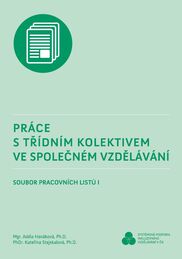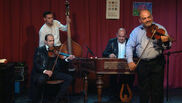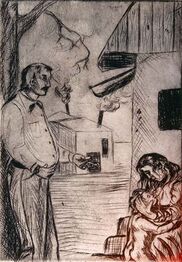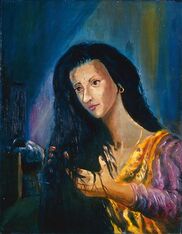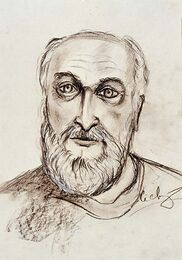Práce s třídním kolektivem ve společném vzdělávání - soubor pracovních listů I
created: 04. 05. 2022 12:15 modified: 05. 05. 2022 13:34
Metodické listy v tomto súbore sú jedným z dvoch súborov pracovných listov „Práca s triednym kolektívom v spoločnom vzdelávaní“. Sú primárne určené ako „nápadník“ pre situácie, keď sa v kolektíve nachádzajú žiaci so špeciálnymi vzdelávacími potrebami, ale sme si istí, že sú inšpirujúcim materiálom pri hľadaní nových ciest, ako umožniť všetkým žiakom dosiahnuť svoje maximum.
Súbory pracovných listov vznikli v rámci projektu Systémová podpora inkluzívneho vzdelávania, ktorý od júla 2013 do júna 2015 realizovala univerzita Palackého v Olomouci v spolupráci s Človekom v núdzi a ďalšími partnermi.
Zdroj: www.clovekvtisni.cz
category: literature
Jozef Kotlár and the Band – Songs
created: 28. 04. 2022 12:37 modified: 28. 04. 2022 12:47
The concert of the Romani folk bands organised by the Folk group Ďusi Band from Prešov provided a chance for the Jozef Kotlár and his band to present their art. The video presents their performance of several dance songs.
Violin: Jozef Kozma Jr.
Cimbalom: Jozef Kozma Sr.
Viola: Jozef Kotlár
Douoble-bass: Ján Kozma
The video was recorded on November 14, 2019 in The Center for Independent Culture Wave in Prešov.
category: music
tags: instrumental modern folk quartet borrowed Jozef Kotlár and the Band general audience internal
Alexandra Kuruczová, Mário Mezei - Sostar dukhal (Why Does It Hurt)
created: 25. 04. 2022 10:18 modified: 25. 04. 2022 10:19
The song Sostar dukhal (Why It Hurts) is a modern song in a slow rhythm, which belongs to the genre of rom-pop, specifically it is a music production by Vlax Roma. It is an artificial song, but the authors of the lyrics and melody could not be identified. Probably the most famous version of this song can be found on the album of the singer L.L.Junior from Hungary, the album titled 'Köszönöm Nektek' (Thank You), from 2002. The emotional text about lost love corresponds with a contemplative way of interpretation. The digital cultural object is a video recording that was created on June 24, 2014 in the village of Zlaté Klasy. The song is interpreted by Alexandra Kuruczová.
category: music
tags: vocal modern rom-pop solo borrowed Romani Alexandra Kuruczová general audience internal
Alexandra Kuruczová, Mário Mezei - Šeje, kana dikhav tuha suno (When I Dream of You)
created: 25. 04. 2022 10:11 modified: 25. 04. 2022 10:14
The song Šeje, kana dikhav tuha suno (When I Dream of You), belongs to the genre of popular dance and entertainment songs within the music production of Vlax Roma in Slovakia. The lyrics of the song are about a man's love for a woman who regularly enters his dreams. The digital cultural object is a video recording that was created on June 24, 2014 in the village of Zlaté Klasy. The performers of the song are Alexandra Kuruczová and Mário Mezei.
category: music
tags: vocal modern rom-pop duet borrowed Romani Alexandra Kuruczová Mário Mezei general audience internal
Alexandra Kuruczová, Mário Mezei - Me tut užarav (I am Waiting for You)
created: 25. 04. 2022 10:00 modified: 25. 04. 2022 10:03
The romantic song Me tut užarav (I am Waiting for You) is a modern song that belongs to the rom-pop genre. Most likely it is an artificial song, but the author of the lyrics and music is unknown. The text is a declaration of love of a man for a woman, the man is willing to wait for her until she makes her own decision. The digital cultural object is a video recording that was created on June 24, 2014 in the village of Zlaté Klasy. The song is interpreted by Alexandra Kuruczová and Mário Mezei.
category: music
tags: vocal modern rom-pop duet borrowed Romani Alexandra Kuruczová Mário Mezei general audience internal
Alexandra Kuruczová, Mário Mezei - Sako ďives (Every Day)
created: 25. 04. 2022 09:45 modified: 25. 04. 2022 09:48
The song Sako ďives (Every day) tells about the loss of a beloved husband and father, about the inner grief of a woman and her dealing with the sudden death of a young man who was the love of her life. This type of song belongs, with its content and form, to the so-called sad songs. The performers of the song are Alexandra Kuruczová and Mário Mezei. The recording was made on June 24, 2014 in the village of Zlaté Klasy.
category: music
tags: vocal modern rom-pop duet borrowed Romani Alexandra Kuruczová Mário Mezei general audience internal
Alexandra Kuruczová, Mário Mezei - Khonik naj Devla kada sar Tu (Nobody is Like You, God)
created: 25. 04. 2022 09:35 modified: 25. 04. 2022 09:36
The song is a cover version of the original song by the singer and preacher of the London Gypsy Church (London Gypsy Church, United Kingdom: www.lgcuk.com) Ricardo Kwiek. The lyrics is inspired by biblical psalms. The song is interpreted by Alexandra Kuruczová and Mário Mezei. The language used in the lyrics is Romani, the Kalderash dialect.
category: music
tags: vocal modern rom-pop duet borrowed Romani Alexandra Kuruczová Mário Mezei general audience internal
Jozef Cichý - The Usurer
created: 04. 04. 2022 11:33 modified: 04. 04. 2022 11:39
The 15 cm x 20 cm drawing portrays the usurer in the Romani settlement. The drawing is titled „The Usurer“. The technique is red clay colour on paper. The author of the drawing is Jozef Cichý. The painting was a part of the collection created by organization Jekhetane-Spolu which was supporting the work of the Romani artists. Jozef Cichý (1966-) is a painter of the Romani origin from the village Nižný Žipov in the district of Trebišov. The vehicle mechanic by profession, devoted many of his years of life to painting exclusively. His artwork is mainly influenced by Salvador Dali, Leonardo da Vinci, Michelangelo Buonarotti and Rafael Santi. He paints mostly with acrylic and oil colours on canvas or sololit. Several of his wall paintings are in churches and funeral houses. The main motives of his artwork are of sacral nature as well as family evironment, war and "romipen". In 90s of the past century he received award for painting in the Slovak competition of amateur art work in Trenčín. Among the works of other Romani artists were his paintings exhibited in Poland, in the Museum of the Romani Culture in Brno, in Bratislava at the exhibition titled Heartprints at the Pallette of Romani Artists, in Prešov, in Michalovce at the exhibition titled Romane čercheňa (Romani Stars) or in Stropkov. Currently, his paintings can be seen in aproximately 30 villages in funeral houses and churches, exhibited in the Museum of Romani Culture in Brno and in other places both in Slovakia and abroad.
category: fine arts
tags: secular material artistic 2D artifact drawing Jozef Cichý general audience internal
Jozef Cichý - Home Alone
created: 04. 04. 2022 11:09 modified: 04. 04. 2022 11:31
The 51 cm x 65 cm drawing is the portrait of the young woman. The portrait’s name is “Home Alone”. The combined technique on plywood. The author of the portrait is Jozef Cichý. The painting was a part of the collection created by organization Jekhetane-Spolu which was supporting the work of the Romani artists. Jozef Cichý (1966-) is a painter of the Romani origin from the village Nižný Žipov in the district of Trebišov. The vehicle mechanic by profession, devoted many of his years of life to painting exclusively. His artwork is mainly influenced by Salvador Dali, Leonardo da Vinci, Michelangelo Buonarotti and Rafael Santi. He paints mostly with acrylic and oil colours on canvas or sololit. Several of his wall paintings are in churches and funeral houses. The main motives of his artwork are of sacral nature as well as family evironment, war and "romipen". In 90s of the past century he received award for painting in the Slovak competition of amateur art work in Trenčín. Among the works of other Romani artists were his paintings exhibited in Poland, in the Museum of the Romani Culture in Brno, in Bratislava at the exhibition titled Heartprints at the Pallette of Romani Artists, in Prešov, in Michalovce at the exhibition titled Romane čercheňa (Romani Stars) or in Stropkov. Currently, his paintings can be seen in aproximately 30 villages in funeral houses and churches, exhibited in the Museum of Romani Culture in Brno and in other places both in Slovakia and abroad.
category: fine arts
tags: secular material artistic 2D artifact painting Jozef Cichý general audience internal
Jozef Cichý - The Portrait of Dušan Pončák
created: 04. 04. 2022 11:03 modified: 04. 04. 2022 11:07
The 30 cm x 42 cm drawing is the portrait of the Slovak sculptor Dušan Pončák. The technique used is drawing with red clay colour on paper. The author of the painting is Jozef Cichý. The painting was a part of the collection created by organization Jekhetane-Spolu which was supporting the work of the Romani artists. Jozef Cichý (1966-) is a painter of the Romani origin from the village Nižný Žipov in the district of Trebišov. The vehicle mechanic by profession, devoted many of his years of life to painting exclusively. His artwork is mainly influenced by Salvador Dali, Leonardo da Vinci, Michelangelo Buonarotti and Rafael Santi. He paints mostly with acrylic and oil colours on canvas or sololit. Several of his wall paintings are in churches and funeral houses. The main motives of his artwork are of sacral nature as well as family evironment, war and "romipen". In 90s of the past century he received award for painting in the Slovak competition of amateur art work in Trenčín. Among the works of other Romani artists were his paintings exhibited in Poland, in the Museum of the Romani Culture in Brno, in Bratislava at the exhibition titled Heartprints at the Pallette of Romani Artists, in Prešov, in Michalovce at the exhibition titled Romane čercheňa (Romani Stars) or in Stropkov. Currently, his paintings can be seen in aproximately 30 villages in funeral houses and churches, exhibited in the Museum of Romani Culture in Brno and in other places both in Slovakia and abroad.
category: fine arts
tags: secular material artistic 2D artifact drawing Jozef Cichý general audience internal




